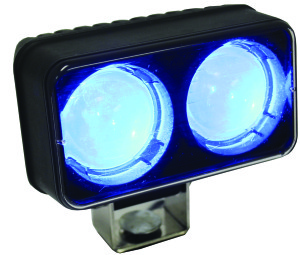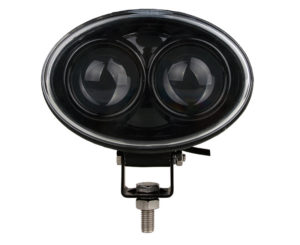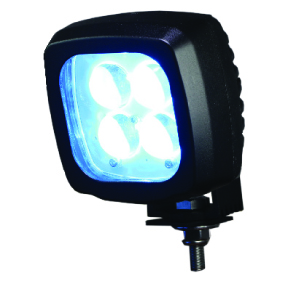Forklift Safety Lights
These intense blue spot led lights keeps pedestrians and other vehicles on notice that a forklift is approaching. Great for blind corners, dock areas, and crossing aisles, these blue spotlights typically shine between 16 and 24 feet beyond the forklift to alert anyone in their path.
The forklift blue lights can be installed on the front and/or back of forklifts or any other industrial equipment. A mounting bracket and wiring is included with each unit providing for a fast and easy installation.
Blue Forklift Safety Light Comparisons
The blue spot safety lights for forklifts vary in many ways. The most important feature of any blue safety light is brightness. We have tested models that had excellent pricing but were less than half as bright, which when projected out 20' were not much more than a fuzzy blue area. Anyone in the vicinity of a forklift will want a distinctive bright blue dot.
The second area of concern is the warranty; most forklift safety lights we have tested have a warranty of six months
to a few years. Our SAFE-LITE and "The Dominator" lights carry a LIFETIME warranty against manufacturing defects and since they are rated for 50,000 hours of use,
you will likely retire before they do. They can also be moved to newer forklifts when leases expire or if you buy new units.
All forklift blue lights are NOT created equal.
Strobe lights, alarms, and other types of safety equipment have a long history with forklifts and other industrial equipment. Actually, they are considered standard equipment by many people forklift producers and are available with each and every new forklift as part of the safety package. Backup sensors could be a very effective tool, regrettably they're super easy to get desensitized to or tune out when you’re listening to them all day, every single day. Obviously, this lowers their effectiveness significantly. Should you hear a safety alarm but ignore it anyway, you’re really no safer than you had been with no safety alarm installed. Strobe lights are another favorite option, but they can be very annoying to the forklift operators, and when installed improperly, they may flash in the operator’s eyes, becoming distracting and resulting in the operator getting into an accident. Once again, we’re no safer now than we were before. Additionally, neither the backup alarm nor the strobe light works well at letting bystanders know where precisely the forklift is coming from, or how quickly. Safety mechanisms may also be so repetitive and annoying, that operators will attempt to thwart them by disconnecting wires or masking lights. If they’re not efficient at ensuring a safe work environment and they’re annoying to everybody nearby, what good are they anyway?
We need a better spot light solution
Despite the fact that safety products like backup alarms and strobe lights appear to be put into lift trucks and other equipment from many different manufacturers as standard issue, they don’t seem to really be doing anything. Whatever value these products had as safety systems was negated as soon as they became so annoying to operators that they started ignoring them completely or even trying to disable them. Clearly, a safety precaution that does not work correctly isn't useful to anybody. Granted, it is difficult to think up a safety system that is noticeable enough to keep people safe, yet doesn’t annoy operators who are exposed to it for long hours at a time. However, we have managed to create such a device through innovation and conversation with operators and safety managers in workplaces across the country. Our
forklift blue safety spot light solves many of these problems in a single neat package. Forklift blue lighting is a popular choice of operators for its unobtrusiveness, ease of visibility, and effectiveness. Warehouse workers praise it for its clear warning without all the annoyance, and managers love it because they can see the effect it has on their safety numbers.
Safety Light Quality Is Important
The product has existed in US marketplaces since about 2013, and it had already been made the standard in other nations prior to that. The forklift blue light was created by a United States forklift manufacturer and initially cost up to $300 dollars each, even without wiring harnesses or wall mounts. Even at this inflated cost, these were very popular. Since that time, a couple of other producers have taken the idea and run with it, making small tweaks and changes that enhance the design and keep prices lower. As with all things, some manufacturers of forklift blue lights do not hold up the rigid quality standards they were initially made with, and there are cheap knockoffs flooding the market. To avoid being taken in by a low quality forklift blue light impression, you will have to shop around and know what you’re looking for. Make certain that any lights you’re thinking about purchasing have wattage of no fewer than 1,300 lumens, come with a lifetime warranty, and also have their UL 583 and 558 ratings, if you need a
UL rated light.
Mounting the Safety Lights
The very best spot to mount the forklift safety spotlight is on the rear of the forklift, given that they spend considerable time operating in reverse, and that's typically when the most accidents happen. Despite the fact that forklift operators are trained to stop and look the direction they’re likely to be heading before moving so much as an inch, everyone knows this isn’t an ideal world and so it doesn’t always happen this way. This is a huge part of the reason that we’ve made blue lights for forklifts- to minimize the side effects of human error. Many people decide to mount the lights towards the front of the forklift, which may be helpful too. One consideration with this particular position is the fact that, based on where they're situated, particularly tall or wide loads could block the beam of light and thus render it useless on occasion. Obviously, you can always put one light on the front and another at the back, but if you do this, you’ll need to make one light red and the other blue (or any other colors), and be consistent about this through the entire fleet of equipment to ensure that everybody knows which color implies that the forklift is traveling forward and which color means that it's travelling backwards. When mounting the lights, try not to damage the overhead guard. The product includes brackets and mounting hardware to let you mount up rapidly without compromising the overhead guard. Also take care not to mount the lights anywhere they may be easily broken, for example outside of the “running lines” of the forklift where they may be easily pushed off and damaged in an accident.
How does a forklift blue light keep me safe?
Forklift blue lights work by casting a vibrant blue light to the ground ahead of or behind the forklift whenever it is in motion. It’s an easy concept, but a surprisingly powerful one. The lights allow forklift operators to determine where other lift trucks are operating, even around corners or in tight spaces with diminished visibility. Watching the movement of the light will inform the operator which direction the other driver is coming from, where they’re headed, how far away they are, and just how fast they're going at a glance. This gives the operators all the information that they need to make safe choices. Blue lighting is also ideal for pedestrian safety, because even when you're walking around the area while distracted, maybe looking at a clipboard or mobile phone, you'll be able to clearly see the bright blue light on the floor ahead, with lots of time for you to become alert and move out of the way of the oncoming vehicle. We hear stories from our customers constantly about the countless times that forklift blue lights have avoided injuries, collisions, and even fatalities around the jobsite. We have earned the respect of operators, pedestrians, and management by creating a safety device that is inconspicuous, tolerable for operators, very good at growing forklift operational safety, and all at an affordable cost with easy installation. Some would refer to it as magic!
Where should the blue spot light shine?
The forklift blue light should be set up in such a way that it shines its light as far ahead of the forklift as possible, while still producing a highly noticeable blue spotlight on the ground. This will ensure that pedestrians and other operators have as much warning as possible, giving them ample time to move out of harm’s way. Cheap lights will shine no more than five or ten feet away, which is simply not adequate. That distance is pretty useless for any pedestrian to see the light just as they are about to be overrun. Good lights shine from a minimum of 15 feet away, and a few even as much as 25 feet to ensure that everyone has ample reaction time to get move into a safer position if necessary. This is particularly important for those who have some fast operators, because, depending on your speed, a forklift could cover a distance of five or ten feet in mere seconds. Make certain that the distance and position of each and every beam on every forklift is strictly uniform, though. Consider the disaster that may be caused if one light shone 8 feet away and yet another shone 18 feet away. Pedestrians may see a blue light coming toward them and think they've ages to get out of the way until they find that this light is mounted differently and the forklift is almost on the top of these already. It is crucial to be consistent with the length of the spotlights for optimum safety and effectiveness. Make sure to mount the lights solidly so they don't move or slip with time, even with heavy use for this same reason. Check them periodically to make sure they are all uniform.
How to setup the blue spotlights
Before installing all of the lights, make sure that the spotlight shows up well on the ground. A great way to ensure this is to point the beam toward the floor at your preferred distance and make certain that the spotlight appears at an adequate brightness. Maybe consider trying out a couple of different distances before settling on one that provides the greatest ratio of spotlight brightness to distance from the origination point. If you're testing two different brands or types of forklift blue light, stage a comparison by mounting each one of these either on a single forklift or two different ones that are drawn up exactly even side by side. Then, simply shine the lights at the same distance setting and see which one results in a brighter spotlight on the ground in front of you. Obviously, a far more scientific method is to test this with a footcandle light meter, the official measurement of light levels, but generally a naked-eye estimation will have the desired effect. In the end, your employees aren’t likely to be travelling with light-calculating equipment- they’re just depending on their own eyes, so if you can’t differentiate between one light and the other just by looking, odds are they won’t either.
A word on warranties
An average warranty on a forklift blue light product may range anywhere from 6 months to the lifetime of the device. Clearly, a lifetime warranty is easily the most desirable and tough to beat because it implies that the maker really stands by their product. The normal procedure in redeeming warranties such as this involves surrendering the damaged light for the manufacture to inspect and potentially repair, then the manufacturer will send a substitute if the reason for the malfunction was one that's covered within their warranty terms and they were unable to repair it. If the lights were broken because of poor mounting positions or because of an accident, they aren’t usually covered under these policies.
The importance of UL ratings
A UL rating is a terrific way to separate the good from the bad when it comes to forklift blue lights, as none but the best quality lights will earn this esteemed rating. Clients who are serious about getting high quality items must only buy UL ranked safety lights. There may be certain workplace regulations that require you to only buy UL rated lights, as well. Cheaper, unrated lights will not only place your company in a questionable legal situation, but they may also potentially begin a fire and cause significant damage to property and people.
Installation
Keep in mind that the price tag on seemingly low cost spotlights might not be what you really end up paying. Oftentimes, the cheaper forklift safety lights include the light only- no wiring material, no wall mounts. You would need to fabricate these yourself at an additional cost, when you might have purchased a slightly more costly, higher quality light with all of those things included. Think hard about taking your fleet into a forklift dealer to have them outfitted using the lights that you supply. Many dealers drastically overcharge for this type of simple procedure. It is better to have a dealer install just the first light while your maintenance team looks on and sees how it’s done, then they should have the ability to mount and install the other lights within minutes.
Compatible Vehicles
The safety spotlight may be used on the majority work vehicles, not just forklifts. Actually, practically any equipment could be outfitted with a blue safety spotlight! Rider lift trucks, order pickers, pallet jacks, and many more can all be outfitted with safety blue lights if necessary. They work nicely on small, quick equipment that moves relatively noiselessly and might be on the losing end of a collision with any of your larger equipment. The lights can make them more noticeable and prevent them from getting into accidents. An imaginative new use for safety lights is getting them mounted to crane hooks. When pointing straight down toward the ground, the spotlight will signal where the hook is heading, and who ought to be getting out of the way before it touches down. You'd require a very bright light with this application, though, since many kinds of cranes employed for these reasons are 20 to 50ft from the ground and operating in daylight conditions. Not just any light is going to work well in those conditions.



